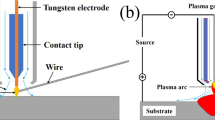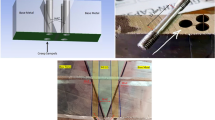Abstract
The electrochemical corrosion properties of S690QL steel weld seams (WSs) processed by laser-induction hybrid welding (LIHW) technology were investigated via their potentiodynamic polarization curves, corrosion surface morphologies, and element distributions, which were obtained by an electrochemical workstation, scanning electron microscopy, and energy-dispersive x-ray spectroscopy. The anode area of the LIHW WS exhibited the most significant passivation. With increasing inductor output power, the secondary passivation phenomenon was enhanced, and the degree of pitting in the corrosion surface increased. Owing to the reduced number of grain boundaries, increased ferrite content, and dense corrosion layer, even though the corrosion current density and corrosion velocity of the LIHW WS increased, the corrosion resistance still increased. In addition, Cr, Ti, and Mo caused the corrosion potential to shift positively. Based on comprehensive analysis, it was concluded that the corrosion resistance of the LIHW WS was improved. This ability was enhanced by the increasing the inductor output power.





Similar content being viewed by others
References
J.R. Zou, J.M. Qian, and H.Q. Li, Jiangsu Ship 28(03), 35 (2011).
A. Cheng, and N. Chen, Eng Fail Anal 84, 262. (2018).
A. Vinoth Jebaraj, L. Ajaykumar, C. R. Deepak, and K. V. V. Aditya, J Adv Res 8, 3, 183 (2017).
H.C. Ma, Z.Y. Liu, C.W. Du, H.R. Wang, X.G. Li, D.W. Zhang, and Z.Y. Cui, Corros Sci 100, 627. (2015).
Q.H. Han, X. Wang, and Y. Lu, Corros Sci 132, 194. (2018).
W. Zhao, and D. Kong, Appl Surf Sci 481, 161. (2019).
E. Rocca, H. Faiz, P. Dillmann, D. Neff, and F. Mirambet, Electrochim Acta 316, 219. (2019).
J. Yang, G.F. Xi, and X.Q. Fan, Appl. Mech. Mater. 80–81, 3. (2011).
S. Gkatzogiannis, J. Weinert, I. Engelhardt, P. Knoedel, and T. Ummenhofer, Int J Fatigue 126, 90. (2019).
X.X. Ma, Y.L. Ma, S.Q. Xing, Z.Y. Chen, H.C. Lu, and H.Z. He, Welded Pipe & Tube 32(12), 22. (2014).
R. Oyyaravelu, P. Kuppan, and N. Arivazhagan, J Adv Res 7(3), 463. (2016).
G. Çam, Ç. Yeni, S. Erim, V. Ventzke, and M. Koçak, Sci Technol Weld Joi 3(4), 177. (1998).
G. Çam, E. S, Y. Ç, and M. Koçak Weld. J. Res. Suppl. 78, 6, 193s (1999).
N. Kashaev, V. Ventzke, and G. Çam, J Manuf Process 36, 571. (2018).
G. Çam, M. Koçak, and J.F.D. Santos, Weld World 43(2), 13. (1999).
J.D. Santos, G. Çam, F. Torster, A. Insfran, and M. Koçak, Weld World 44(6), 42. (2000).
G. Çam, and G. İpekoğlu, Int. J. Adv. Manuf. Technol. 91(5–8), 1851. (2017).
G. Çam, and M. Koçak, Int Mater Rev 43(1), 1 (1998).
G. Çam, and M. Koçak, Sci. Technol. Weld. Joining 3(3), 105. (1998).
G. Çam, A. Fischer, R. Ratjen, J. F. Santos and M. Koçak, "Properties of laser beam welded superalloys Inconel 625 and 718", In: Proc. of 7th European Conference on Laser Treatment of Materials, ECLAT '98, B. L. Mordike, Ed. (Werkstoff-Informationsgeselschaft mbH,Frankfurt, Hannover, Germany, 1998), p. 333.
Von Strombeck A, G. Çam, J. F. Santos, V. Ventzke and M. Koçak, "A comparison between microstructure, properties, and toughness behavior of power beam and friction stir welds in Al-alloys", In: Proc. of the TMS 2001 Annual Meeting Aluminum, Automotive and Joining, J. G. K. A. S. K. Das, Ed. (TMS, Warrendale, PA, USA, (New Orleans, Louisiana, USA, 2001), p. 249.
S. Riekehr, G. Çam, J. F. Santos, M. Koçak, and R. M. Klein, "Investigation on fracture toughness of laser beam welded steels", In: Proc. of 7th European Conference on Laser Treatment of Materials (ECLAT '98), B. L. Mordike, Ed. (Werkstoff-Informationsgeselschaft mbH, Frankfurt, Hannover, Germany, 1998), p. 405.
G. Turichin, M. Kuznetsov, I. Tsibulskiy, A. Firsova, G. Turichin, M. Kuznetsov, I. Tsibulskiy, A. Firsova, G. Turichin, and M. Kuznetsov, Phys. Procedia 89, 156–163. (2017).
H. Pinto, and A.R.K. Axel, Mater Technol 80(1), 39–49. (2009).
G.K. Ahiale, and Y. Oh, Mater. Sci. Eng., A 597, 342–348. (2014).
Y.F. Sun, J.M. Shen, Y. Morisada, and H. Fujii, Mater. Des. 1980–2015 (54), 450–457. (2014).
A.I. Álvarez, V. Cid, G. Pena, J. Sotelo, and D. Verdera, assisted friction stir welding of carbon steel: Use of induction and laser as preheating techniques (John Wiley & Sons Inc, Hoboken, NJ, USA, 2013), pp 117–126.
A. Ikram, N. Arif, and H. Chung, J Mater Process Tech 231, 162–170. (2016).
L. Li, G. Mi, and C. Wang, J Manuf Process 43, 276–291. (2019).
L. Li, G. Mi, X. Zhang, L. Xiong, Z. Zhu, and C. Wang, Optics Laser Technol. 119, 105606. (2019).
L. Li, J. Zheng, and C. Wang, Optics Laser Technol. 126, 106101. (2020).
L. Gong, Q. Xing, and H. Wang, Anti-Corros Method M 63(4), 295–300. (2016).
T. Jun, L.I. Guo-Ming, and C. Shan, Equip. Environ. Eng. 13(2), 110–115. (2016).
Acknowledgements
We would like to express our deep gratitude to the Analysis and Test Center of HUST (Huazhong University of Science and Technology) and the State Key Laboratory of Material Processing and Die & Mould Technology of HUST for their friendly cooperation. We thank LetPub (www.letpub.com) for its linguistic assistance during the preparation of this manuscript.
Funding
This study was funded by the Elite Program research support fund of Shandong University of Science and Technology [Grant Number 11040025401], the National Natural Science Foundation of China [Grant Number 51705173] and Natural Science Foundation of Shandong Province [Grant Number ZR2020KE0].
Author information
Authors and Affiliations
Corresponding author
Ethics declarations
Conflict of interest
On behalf of all authors, the corresponding author states that there is no conflict of interest.
Additional information
Publisher's Note
Springer Nature remains neutral with regard to jurisdictional claims in published maps and institutional affiliations.
Supplementary Information
Below is the link to the electronic supplementary material.
Rights and permissions
About this article
Cite this article
Li, L., Lou, S. & Wang, C. Improvement of Laser-Induction Hybrid Welding Processing on Electrochemical Corrosion Properties of S690QL Steel Weld Seam. JOM 74, 3607–3615 (2022). https://doi.org/10.1007/s11837-022-05281-5
Received:
Accepted:
Published:
Issue Date:
DOI: https://doi.org/10.1007/s11837-022-05281-5




